Sustainable Tourism Development in Qatar
VerifiedAdded on 2020/10/22
|13
|4273
|277
AI Summary
The provided document delves into the topic of sustainable tourism development in Qatar, highlighting key aspects such as social, economic, and environmental considerations. The focus is on effectively utilizing resources and involving stakeholders to make favorable decisions regarding tourism development in Qatar.
Contribute Materials
Your contribution can guide someone’s learning journey. Share your
documents today.

SUSTAINABLE TOURISM
DEVELOPMENT
DEVELOPMENT
Secure Best Marks with AI Grader
Need help grading? Try our AI Grader for instant feedback on your assignments.
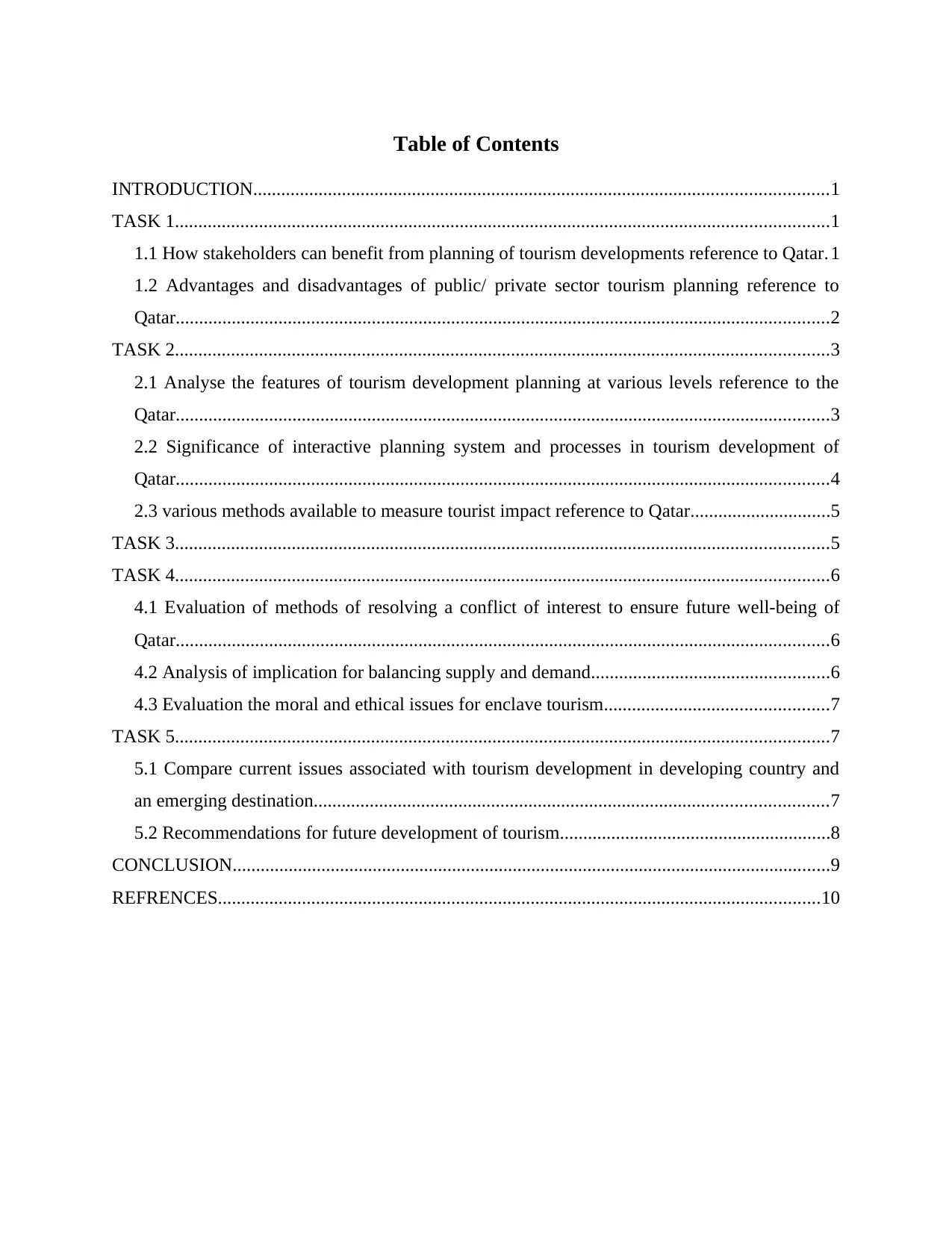
Table of Contents
INTRODUCTION...........................................................................................................................1
TASK 1............................................................................................................................................1
1.1 How stakeholders can benefit from planning of tourism developments reference to Qatar. 1
1.2 Advantages and disadvantages of public/ private sector tourism planning reference to
Qatar............................................................................................................................................2
TASK 2............................................................................................................................................3
2.1 Analyse the features of tourism development planning at various levels reference to the
Qatar............................................................................................................................................3
2.2 Significance of interactive planning system and processes in tourism development of
Qatar............................................................................................................................................4
2.3 various methods available to measure tourist impact reference to Qatar..............................5
TASK 3............................................................................................................................................5
TASK 4............................................................................................................................................6
4.1 Evaluation of methods of resolving a conflict of interest to ensure future well-being of
Qatar............................................................................................................................................6
4.2 Analysis of implication for balancing supply and demand...................................................6
4.3 Evaluation the moral and ethical issues for enclave tourism................................................7
TASK 5............................................................................................................................................7
5.1 Compare current issues associated with tourism development in developing country and
an emerging destination..............................................................................................................7
5.2 Recommendations for future development of tourism..........................................................8
CONCLUSION................................................................................................................................9
REFRENCES.................................................................................................................................10
INTRODUCTION...........................................................................................................................1
TASK 1............................................................................................................................................1
1.1 How stakeholders can benefit from planning of tourism developments reference to Qatar. 1
1.2 Advantages and disadvantages of public/ private sector tourism planning reference to
Qatar............................................................................................................................................2
TASK 2............................................................................................................................................3
2.1 Analyse the features of tourism development planning at various levels reference to the
Qatar............................................................................................................................................3
2.2 Significance of interactive planning system and processes in tourism development of
Qatar............................................................................................................................................4
2.3 various methods available to measure tourist impact reference to Qatar..............................5
TASK 3............................................................................................................................................5
TASK 4............................................................................................................................................6
4.1 Evaluation of methods of resolving a conflict of interest to ensure future well-being of
Qatar............................................................................................................................................6
4.2 Analysis of implication for balancing supply and demand...................................................6
4.3 Evaluation the moral and ethical issues for enclave tourism................................................7
TASK 5............................................................................................................................................7
5.1 Compare current issues associated with tourism development in developing country and
an emerging destination..............................................................................................................7
5.2 Recommendations for future development of tourism..........................................................8
CONCLUSION................................................................................................................................9
REFRENCES.................................................................................................................................10
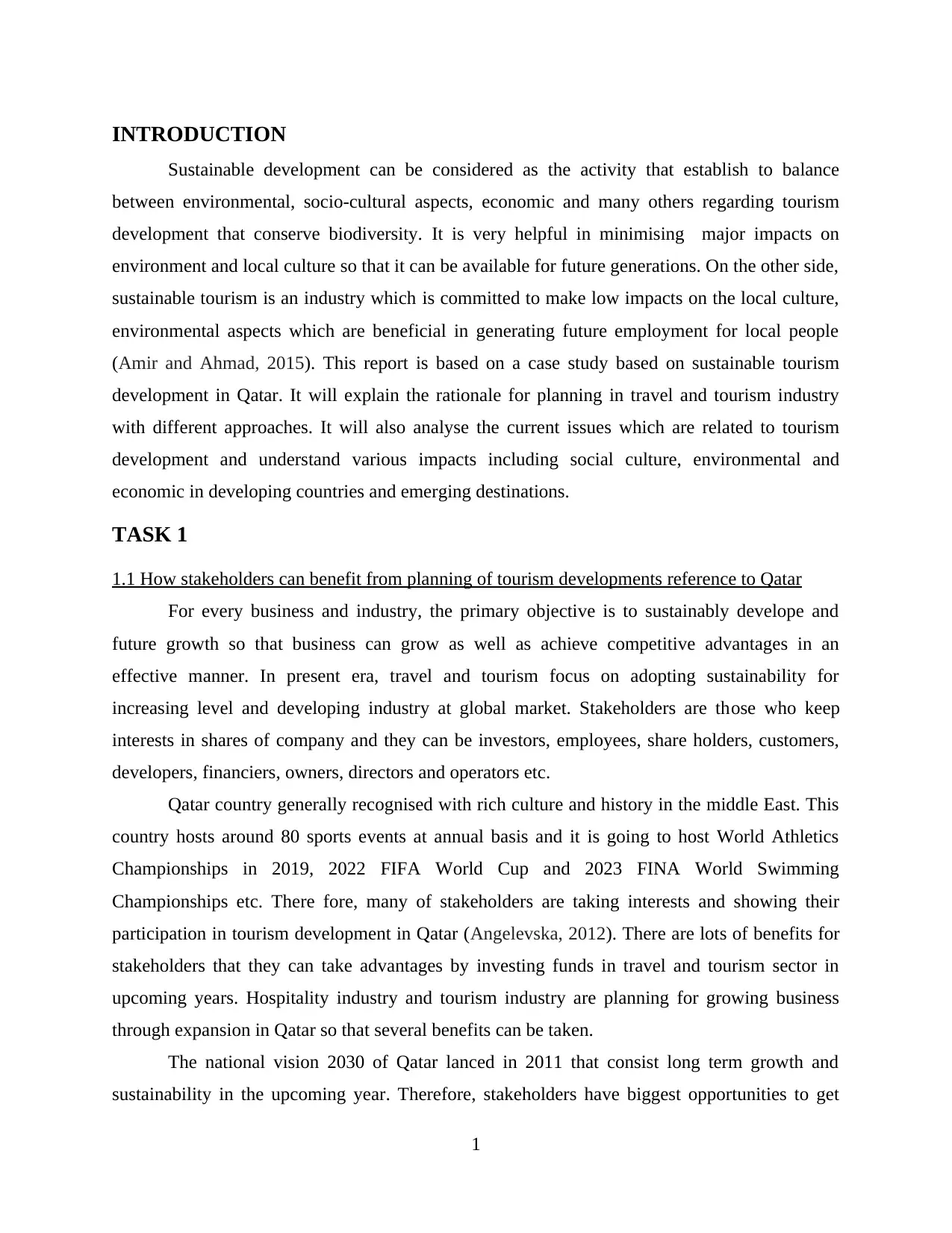
INTRODUCTION
Sustainable development can be considered as the activity that establish to balance
between environmental, socio-cultural aspects, economic and many others regarding tourism
development that conserve biodiversity. It is very helpful in minimising major impacts on
environment and local culture so that it can be available for future generations. On the other side,
sustainable tourism is an industry which is committed to make low impacts on the local culture,
environmental aspects which are beneficial in generating future employment for local people
(Amir and Ahmad, 2015). This report is based on a case study based on sustainable tourism
development in Qatar. It will explain the rationale for planning in travel and tourism industry
with different approaches. It will also analyse the current issues which are related to tourism
development and understand various impacts including social culture, environmental and
economic in developing countries and emerging destinations.
TASK 1
1.1 How stakeholders can benefit from planning of tourism developments reference to Qatar
For every business and industry, the primary objective is to sustainably develope and
future growth so that business can grow as well as achieve competitive advantages in an
effective manner. In present era, travel and tourism focus on adopting sustainability for
increasing level and developing industry at global market. Stakeholders are those who keep
interests in shares of company and they can be investors, employees, share holders, customers,
developers, financiers, owners, directors and operators etc.
Qatar country generally recognised with rich culture and history in the middle East. This
country hosts around 80 sports events at annual basis and it is going to host World Athletics
Championships in 2019, 2022 FIFA World Cup and 2023 FINA World Swimming
Championships etc. There fore, many of stakeholders are taking interests and showing their
participation in tourism development in Qatar (Angelevska, 2012). There are lots of benefits for
stakeholders that they can take advantages by investing funds in travel and tourism sector in
upcoming years. Hospitality industry and tourism industry are planning for growing business
through expansion in Qatar so that several benefits can be taken.
The national vision 2030 of Qatar lanced in 2011 that consist long term growth and
sustainability in the upcoming year. Therefore, stakeholders have biggest opportunities to get
1
Sustainable development can be considered as the activity that establish to balance
between environmental, socio-cultural aspects, economic and many others regarding tourism
development that conserve biodiversity. It is very helpful in minimising major impacts on
environment and local culture so that it can be available for future generations. On the other side,
sustainable tourism is an industry which is committed to make low impacts on the local culture,
environmental aspects which are beneficial in generating future employment for local people
(Amir and Ahmad, 2015). This report is based on a case study based on sustainable tourism
development in Qatar. It will explain the rationale for planning in travel and tourism industry
with different approaches. It will also analyse the current issues which are related to tourism
development and understand various impacts including social culture, environmental and
economic in developing countries and emerging destinations.
TASK 1
1.1 How stakeholders can benefit from planning of tourism developments reference to Qatar
For every business and industry, the primary objective is to sustainably develope and
future growth so that business can grow as well as achieve competitive advantages in an
effective manner. In present era, travel and tourism focus on adopting sustainability for
increasing level and developing industry at global market. Stakeholders are those who keep
interests in shares of company and they can be investors, employees, share holders, customers,
developers, financiers, owners, directors and operators etc.
Qatar country generally recognised with rich culture and history in the middle East. This
country hosts around 80 sports events at annual basis and it is going to host World Athletics
Championships in 2019, 2022 FIFA World Cup and 2023 FINA World Swimming
Championships etc. There fore, many of stakeholders are taking interests and showing their
participation in tourism development in Qatar (Angelevska, 2012). There are lots of benefits for
stakeholders that they can take advantages by investing funds in travel and tourism sector in
upcoming years. Hospitality industry and tourism industry are planning for growing business
through expansion in Qatar so that several benefits can be taken.
The national vision 2030 of Qatar lanced in 2011 that consist long term growth and
sustainability in the upcoming year. Therefore, stakeholders have biggest opportunities to get
1

more benefits or advantages through economic growth of Qatar. They are focusing on
partnership project of public and private that will bring various changes and utilise
comprehensive skills in an effective manner. Private sector can come up with new ideas, talents,
knowledge and skills for completing project in well manner. Public sector organisations support
in arranging resources and manage them effectively so that goals or targets can be accomplished
(Najdeska, 2012). Both sector play vital role in enhancing productivity and developing society as
well as build good relationship among public and private partners of the tourism industry that
leads better improvement in working within partnership. The main purpose of tourism planning
are providing employment opportunities, protections and conservation of wildlife, co-ordination
among public and private partnership regarding completing any project. On the other hand,
infrastructure can be improved in Qatar. They can get maximum benefits and provide protections
consumers during visiting any place.
1.2 Advantages and disadvantages of public/ private sector tourism planning reference to Qatar
In the present scenario, public and private partnership (PPP) can be seen for completing
in projects for country development. It consists collaboration between private and public sector
to enhance growth and sustainable development in travel and tourism industry. Public and
private tourism planning play vital role in developing sustainability of tourism sector of Qatar.
There are various advantages and disadvantages of PPP model such as:
Advantages:
They create employment opportunities for social people or local community so as to
reduce poverty (Boukas, Ziakas2014). This will support in raising income level and
improve standard of living of Qatar's people in well manner.
PPP model is also helpful in utilising available resources by providing proper protection
to the natural and environmental aspects so that country can be developed and achieve
sustainable growth in tourism sector.
Public and private tourism planning will support in encouraging available resources and
use them effectively for better culture, heritage, human resources, infrastructure and
natural resources as well.
2
partnership project of public and private that will bring various changes and utilise
comprehensive skills in an effective manner. Private sector can come up with new ideas, talents,
knowledge and skills for completing project in well manner. Public sector organisations support
in arranging resources and manage them effectively so that goals or targets can be accomplished
(Najdeska, 2012). Both sector play vital role in enhancing productivity and developing society as
well as build good relationship among public and private partners of the tourism industry that
leads better improvement in working within partnership. The main purpose of tourism planning
are providing employment opportunities, protections and conservation of wildlife, co-ordination
among public and private partnership regarding completing any project. On the other hand,
infrastructure can be improved in Qatar. They can get maximum benefits and provide protections
consumers during visiting any place.
1.2 Advantages and disadvantages of public/ private sector tourism planning reference to Qatar
In the present scenario, public and private partnership (PPP) can be seen for completing
in projects for country development. It consists collaboration between private and public sector
to enhance growth and sustainable development in travel and tourism industry. Public and
private tourism planning play vital role in developing sustainability of tourism sector of Qatar.
There are various advantages and disadvantages of PPP model such as:
Advantages:
They create employment opportunities for social people or local community so as to
reduce poverty (Boukas, Ziakas2014). This will support in raising income level and
improve standard of living of Qatar's people in well manner.
PPP model is also helpful in utilising available resources by providing proper protection
to the natural and environmental aspects so that country can be developed and achieve
sustainable growth in tourism sector.
Public and private tourism planning will support in encouraging available resources and
use them effectively for better culture, heritage, human resources, infrastructure and
natural resources as well.
2
Secure Best Marks with AI Grader
Need help grading? Try our AI Grader for instant feedback on your assignments.
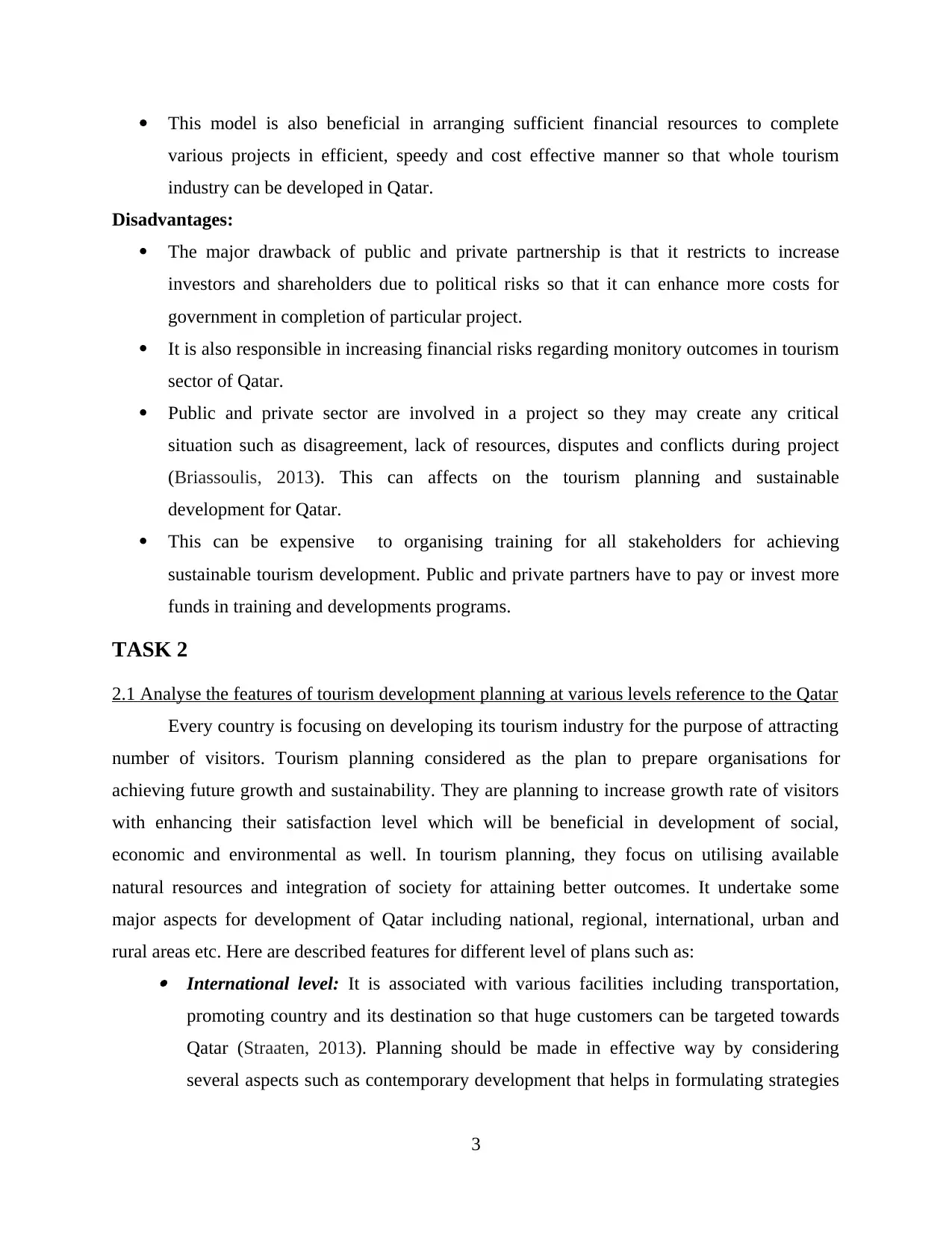
This model is also beneficial in arranging sufficient financial resources to complete
various projects in efficient, speedy and cost effective manner so that whole tourism
industry can be developed in Qatar.
Disadvantages:
The major drawback of public and private partnership is that it restricts to increase
investors and shareholders due to political risks so that it can enhance more costs for
government in completion of particular project.
It is also responsible in increasing financial risks regarding monitory outcomes in tourism
sector of Qatar.
Public and private sector are involved in a project so they may create any critical
situation such as disagreement, lack of resources, disputes and conflicts during project
(Briassoulis, 2013). This can affects on the tourism planning and sustainable
development for Qatar.
This can be expensive to organising training for all stakeholders for achieving
sustainable tourism development. Public and private partners have to pay or invest more
funds in training and developments programs.
TASK 2
2.1 Analyse the features of tourism development planning at various levels reference to the Qatar
Every country is focusing on developing its tourism industry for the purpose of attracting
number of visitors. Tourism planning considered as the plan to prepare organisations for
achieving future growth and sustainability. They are planning to increase growth rate of visitors
with enhancing their satisfaction level which will be beneficial in development of social,
economic and environmental as well. In tourism planning, they focus on utilising available
natural resources and integration of society for attaining better outcomes. It undertake some
major aspects for development of Qatar including national, regional, international, urban and
rural areas etc. Here are described features for different level of plans such as:
International level: It is associated with various facilities including transportation,
promoting country and its destination so that huge customers can be targeted towards
Qatar (Straaten, 2013). Planning should be made in effective way by considering
several aspects such as contemporary development that helps in formulating strategies
3
various projects in efficient, speedy and cost effective manner so that whole tourism
industry can be developed in Qatar.
Disadvantages:
The major drawback of public and private partnership is that it restricts to increase
investors and shareholders due to political risks so that it can enhance more costs for
government in completion of particular project.
It is also responsible in increasing financial risks regarding monitory outcomes in tourism
sector of Qatar.
Public and private sector are involved in a project so they may create any critical
situation such as disagreement, lack of resources, disputes and conflicts during project
(Briassoulis, 2013). This can affects on the tourism planning and sustainable
development for Qatar.
This can be expensive to organising training for all stakeholders for achieving
sustainable tourism development. Public and private partners have to pay or invest more
funds in training and developments programs.
TASK 2
2.1 Analyse the features of tourism development planning at various levels reference to the Qatar
Every country is focusing on developing its tourism industry for the purpose of attracting
number of visitors. Tourism planning considered as the plan to prepare organisations for
achieving future growth and sustainability. They are planning to increase growth rate of visitors
with enhancing their satisfaction level which will be beneficial in development of social,
economic and environmental as well. In tourism planning, they focus on utilising available
natural resources and integration of society for attaining better outcomes. It undertake some
major aspects for development of Qatar including national, regional, international, urban and
rural areas etc. Here are described features for different level of plans such as:
International level: It is associated with various facilities including transportation,
promoting country and its destination so that huge customers can be targeted towards
Qatar (Straaten, 2013). Planning should be made in effective way by considering
several aspects such as contemporary development that helps in formulating strategies
3
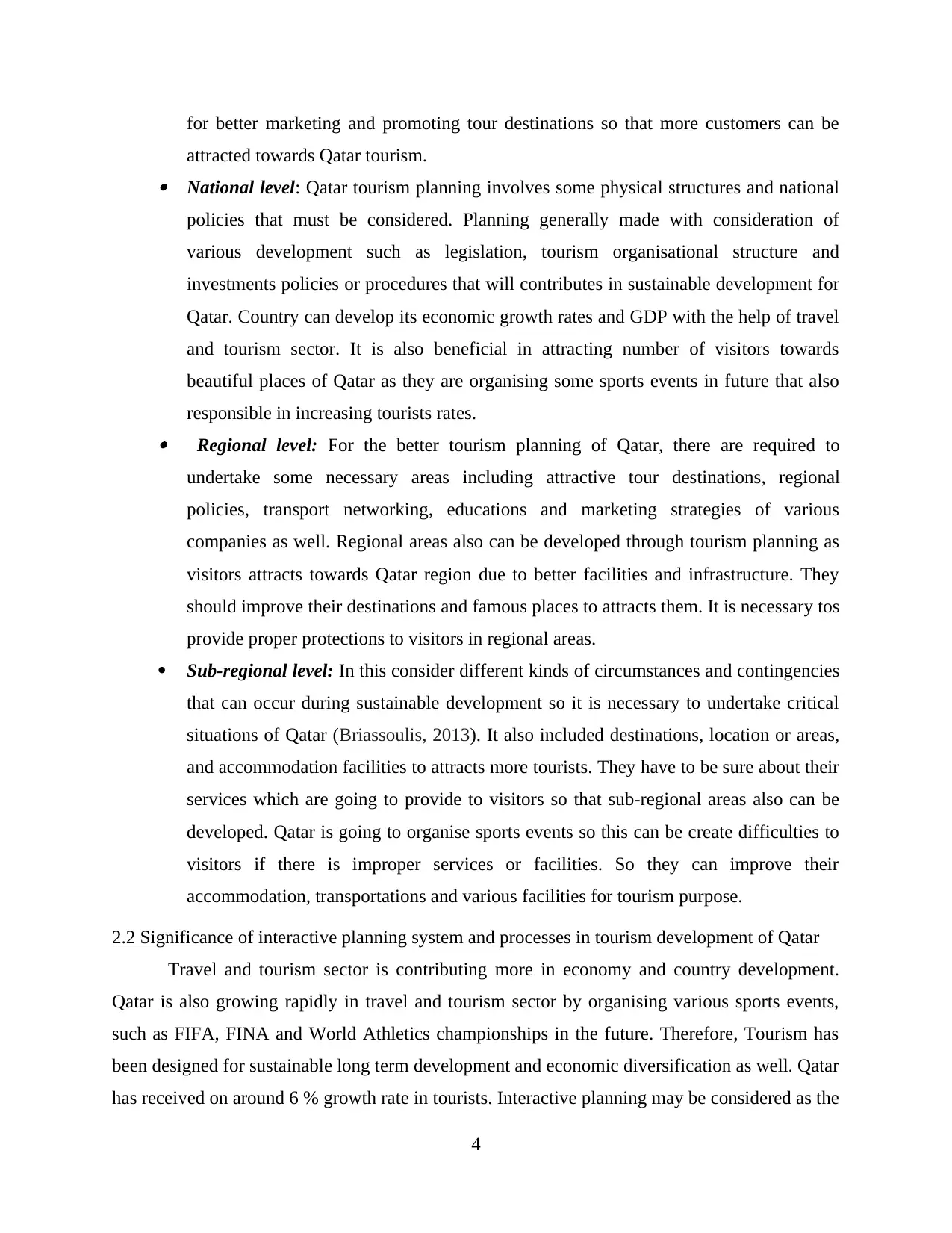
for better marketing and promoting tour destinations so that more customers can be
attracted towards Qatar tourism.
National level: Qatar tourism planning involves some physical structures and national
policies that must be considered. Planning generally made with consideration of
various development such as legislation, tourism organisational structure and
investments policies or procedures that will contributes in sustainable development for
Qatar. Country can develop its economic growth rates and GDP with the help of travel
and tourism sector. It is also beneficial in attracting number of visitors towards
beautiful places of Qatar as they are organising some sports events in future that also
responsible in increasing tourists rates.
Regional level: For the better tourism planning of Qatar, there are required to
undertake some necessary areas including attractive tour destinations, regional
policies, transport networking, educations and marketing strategies of various
companies as well. Regional areas also can be developed through tourism planning as
visitors attracts towards Qatar region due to better facilities and infrastructure. They
should improve their destinations and famous places to attracts them. It is necessary tos
provide proper protections to visitors in regional areas.
Sub-regional level: In this consider different kinds of circumstances and contingencies
that can occur during sustainable development so it is necessary to undertake critical
situations of Qatar (Briassoulis, 2013). It also included destinations, location or areas,
and accommodation facilities to attracts more tourists. They have to be sure about their
services which are going to provide to visitors so that sub-regional areas also can be
developed. Qatar is going to organise sports events so this can be create difficulties to
visitors if there is improper services or facilities. So they can improve their
accommodation, transportations and various facilities for tourism purpose.
2.2 Significance of interactive planning system and processes in tourism development of Qatar
Travel and tourism sector is contributing more in economy and country development.
Qatar is also growing rapidly in travel and tourism sector by organising various sports events,
such as FIFA, FINA and World Athletics championships in the future. Therefore, Tourism has
been designed for sustainable long term development and economic diversification as well. Qatar
has received on around 6 % growth rate in tourists. Interactive planning may be considered as the
4
attracted towards Qatar tourism.
National level: Qatar tourism planning involves some physical structures and national
policies that must be considered. Planning generally made with consideration of
various development such as legislation, tourism organisational structure and
investments policies or procedures that will contributes in sustainable development for
Qatar. Country can develop its economic growth rates and GDP with the help of travel
and tourism sector. It is also beneficial in attracting number of visitors towards
beautiful places of Qatar as they are organising some sports events in future that also
responsible in increasing tourists rates.
Regional level: For the better tourism planning of Qatar, there are required to
undertake some necessary areas including attractive tour destinations, regional
policies, transport networking, educations and marketing strategies of various
companies as well. Regional areas also can be developed through tourism planning as
visitors attracts towards Qatar region due to better facilities and infrastructure. They
should improve their destinations and famous places to attracts them. It is necessary tos
provide proper protections to visitors in regional areas.
Sub-regional level: In this consider different kinds of circumstances and contingencies
that can occur during sustainable development so it is necessary to undertake critical
situations of Qatar (Briassoulis, 2013). It also included destinations, location or areas,
and accommodation facilities to attracts more tourists. They have to be sure about their
services which are going to provide to visitors so that sub-regional areas also can be
developed. Qatar is going to organise sports events so this can be create difficulties to
visitors if there is improper services or facilities. So they can improve their
accommodation, transportations and various facilities for tourism purpose.
2.2 Significance of interactive planning system and processes in tourism development of Qatar
Travel and tourism sector is contributing more in economy and country development.
Qatar is also growing rapidly in travel and tourism sector by organising various sports events,
such as FIFA, FINA and World Athletics championships in the future. Therefore, Tourism has
been designed for sustainable long term development and economic diversification as well. Qatar
has received on around 6 % growth rate in tourists. Interactive planning may be considered as the
4
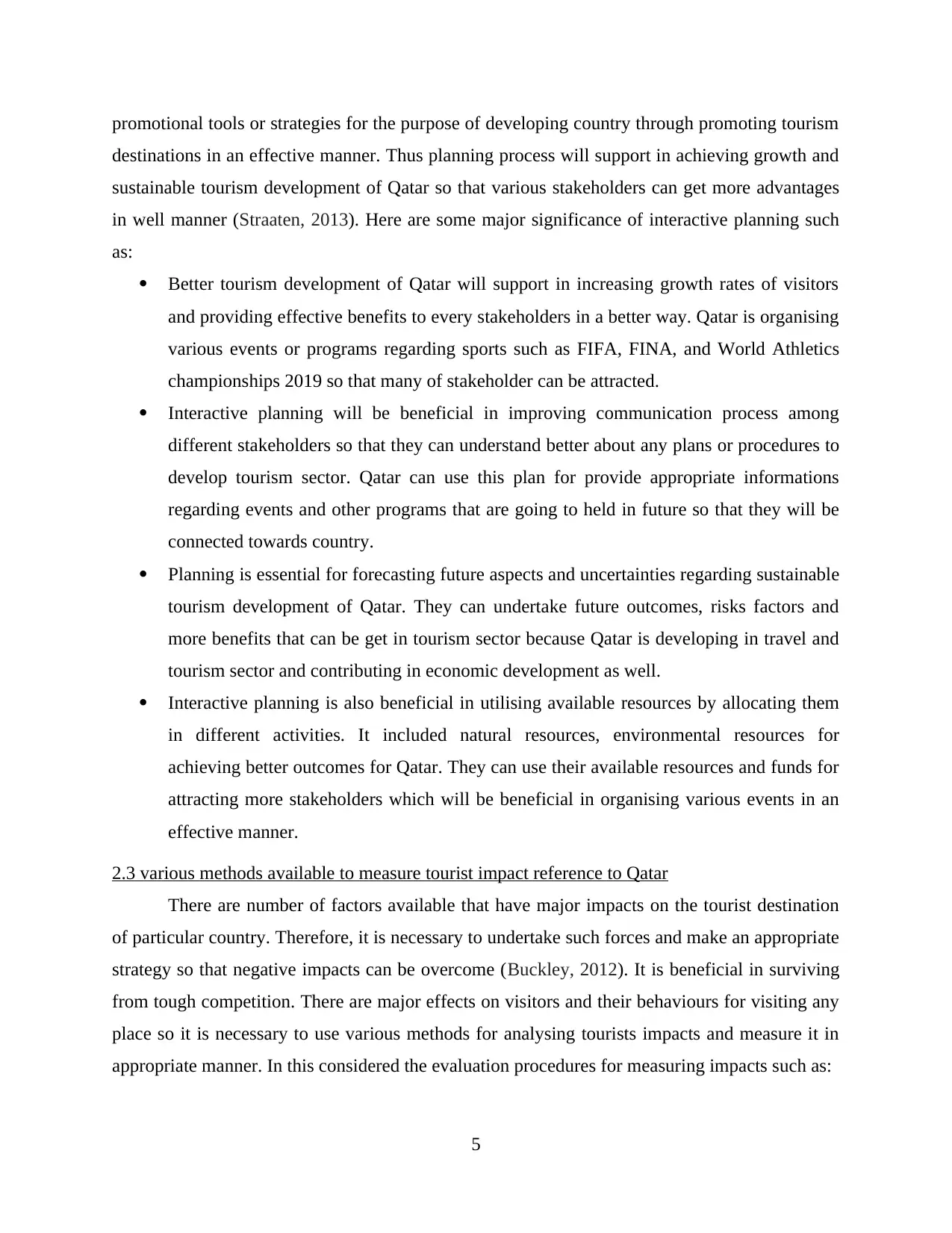
promotional tools or strategies for the purpose of developing country through promoting tourism
destinations in an effective manner. Thus planning process will support in achieving growth and
sustainable tourism development of Qatar so that various stakeholders can get more advantages
in well manner (Straaten, 2013). Here are some major significance of interactive planning such
as:
Better tourism development of Qatar will support in increasing growth rates of visitors
and providing effective benefits to every stakeholders in a better way. Qatar is organising
various events or programs regarding sports such as FIFA, FINA, and World Athletics
championships 2019 so that many of stakeholder can be attracted.
Interactive planning will be beneficial in improving communication process among
different stakeholders so that they can understand better about any plans or procedures to
develop tourism sector. Qatar can use this plan for provide appropriate informations
regarding events and other programs that are going to held in future so that they will be
connected towards country.
Planning is essential for forecasting future aspects and uncertainties regarding sustainable
tourism development of Qatar. They can undertake future outcomes, risks factors and
more benefits that can be get in tourism sector because Qatar is developing in travel and
tourism sector and contributing in economic development as well.
Interactive planning is also beneficial in utilising available resources by allocating them
in different activities. It included natural resources, environmental resources for
achieving better outcomes for Qatar. They can use their available resources and funds for
attracting more stakeholders which will be beneficial in organising various events in an
effective manner.
2.3 various methods available to measure tourist impact reference to Qatar
There are number of factors available that have major impacts on the tourist destination
of particular country. Therefore, it is necessary to undertake such forces and make an appropriate
strategy so that negative impacts can be overcome (Buckley, 2012). It is beneficial in surviving
from tough competition. There are major effects on visitors and their behaviours for visiting any
place so it is necessary to use various methods for analysing tourists impacts and measure it in
appropriate manner. In this considered the evaluation procedures for measuring impacts such as:
5
destinations in an effective manner. Thus planning process will support in achieving growth and
sustainable tourism development of Qatar so that various stakeholders can get more advantages
in well manner (Straaten, 2013). Here are some major significance of interactive planning such
as:
Better tourism development of Qatar will support in increasing growth rates of visitors
and providing effective benefits to every stakeholders in a better way. Qatar is organising
various events or programs regarding sports such as FIFA, FINA, and World Athletics
championships 2019 so that many of stakeholder can be attracted.
Interactive planning will be beneficial in improving communication process among
different stakeholders so that they can understand better about any plans or procedures to
develop tourism sector. Qatar can use this plan for provide appropriate informations
regarding events and other programs that are going to held in future so that they will be
connected towards country.
Planning is essential for forecasting future aspects and uncertainties regarding sustainable
tourism development of Qatar. They can undertake future outcomes, risks factors and
more benefits that can be get in tourism sector because Qatar is developing in travel and
tourism sector and contributing in economic development as well.
Interactive planning is also beneficial in utilising available resources by allocating them
in different activities. It included natural resources, environmental resources for
achieving better outcomes for Qatar. They can use their available resources and funds for
attracting more stakeholders which will be beneficial in organising various events in an
effective manner.
2.3 various methods available to measure tourist impact reference to Qatar
There are number of factors available that have major impacts on the tourist destination
of particular country. Therefore, it is necessary to undertake such forces and make an appropriate
strategy so that negative impacts can be overcome (Buckley, 2012). It is beneficial in surviving
from tough competition. There are major effects on visitors and their behaviours for visiting any
place so it is necessary to use various methods for analysing tourists impacts and measure it in
appropriate manner. In this considered the evaluation procedures for measuring impacts such as:
5
Paraphrase This Document
Need a fresh take? Get an instant paraphrase of this document with our AI Paraphraser
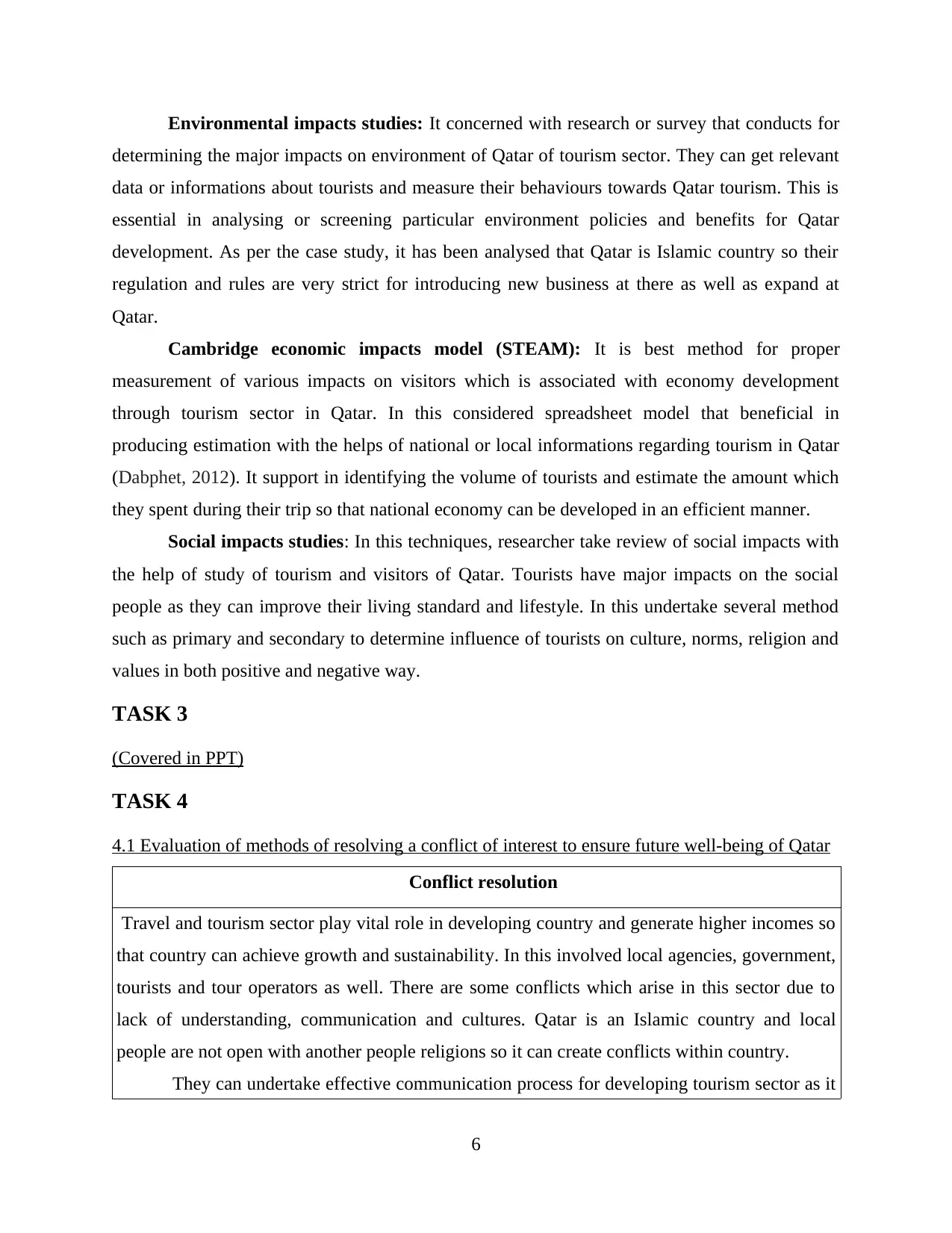
Environmental impacts studies: It concerned with research or survey that conducts for
determining the major impacts on environment of Qatar of tourism sector. They can get relevant
data or informations about tourists and measure their behaviours towards Qatar tourism. This is
essential in analysing or screening particular environment policies and benefits for Qatar
development. As per the case study, it has been analysed that Qatar is Islamic country so their
regulation and rules are very strict for introducing new business at there as well as expand at
Qatar.
Cambridge economic impacts model (STEAM): It is best method for proper
measurement of various impacts on visitors which is associated with economy development
through tourism sector in Qatar. In this considered spreadsheet model that beneficial in
producing estimation with the helps of national or local informations regarding tourism in Qatar
(Dabphet, 2012). It support in identifying the volume of tourists and estimate the amount which
they spent during their trip so that national economy can be developed in an efficient manner.
Social impacts studies: In this techniques, researcher take review of social impacts with
the help of study of tourism and visitors of Qatar. Tourists have major impacts on the social
people as they can improve their living standard and lifestyle. In this undertake several method
such as primary and secondary to determine influence of tourists on culture, norms, religion and
values in both positive and negative way.
TASK 3
(Covered in PPT)
TASK 4
4.1 Evaluation of methods of resolving a conflict of interest to ensure future well-being of Qatar
Conflict resolution
Travel and tourism sector play vital role in developing country and generate higher incomes so
that country can achieve growth and sustainability. In this involved local agencies, government,
tourists and tour operators as well. There are some conflicts which arise in this sector due to
lack of understanding, communication and cultures. Qatar is an Islamic country and local
people are not open with another people religions so it can create conflicts within country.
They can undertake effective communication process for developing tourism sector as it
6
determining the major impacts on environment of Qatar of tourism sector. They can get relevant
data or informations about tourists and measure their behaviours towards Qatar tourism. This is
essential in analysing or screening particular environment policies and benefits for Qatar
development. As per the case study, it has been analysed that Qatar is Islamic country so their
regulation and rules are very strict for introducing new business at there as well as expand at
Qatar.
Cambridge economic impacts model (STEAM): It is best method for proper
measurement of various impacts on visitors which is associated with economy development
through tourism sector in Qatar. In this considered spreadsheet model that beneficial in
producing estimation with the helps of national or local informations regarding tourism in Qatar
(Dabphet, 2012). It support in identifying the volume of tourists and estimate the amount which
they spent during their trip so that national economy can be developed in an efficient manner.
Social impacts studies: In this techniques, researcher take review of social impacts with
the help of study of tourism and visitors of Qatar. Tourists have major impacts on the social
people as they can improve their living standard and lifestyle. In this undertake several method
such as primary and secondary to determine influence of tourists on culture, norms, religion and
values in both positive and negative way.
TASK 3
(Covered in PPT)
TASK 4
4.1 Evaluation of methods of resolving a conflict of interest to ensure future well-being of Qatar
Conflict resolution
Travel and tourism sector play vital role in developing country and generate higher incomes so
that country can achieve growth and sustainability. In this involved local agencies, government,
tourists and tour operators as well. There are some conflicts which arise in this sector due to
lack of understanding, communication and cultures. Qatar is an Islamic country and local
people are not open with another people religions so it can create conflicts within country.
They can undertake effective communication process for developing tourism sector as it
6
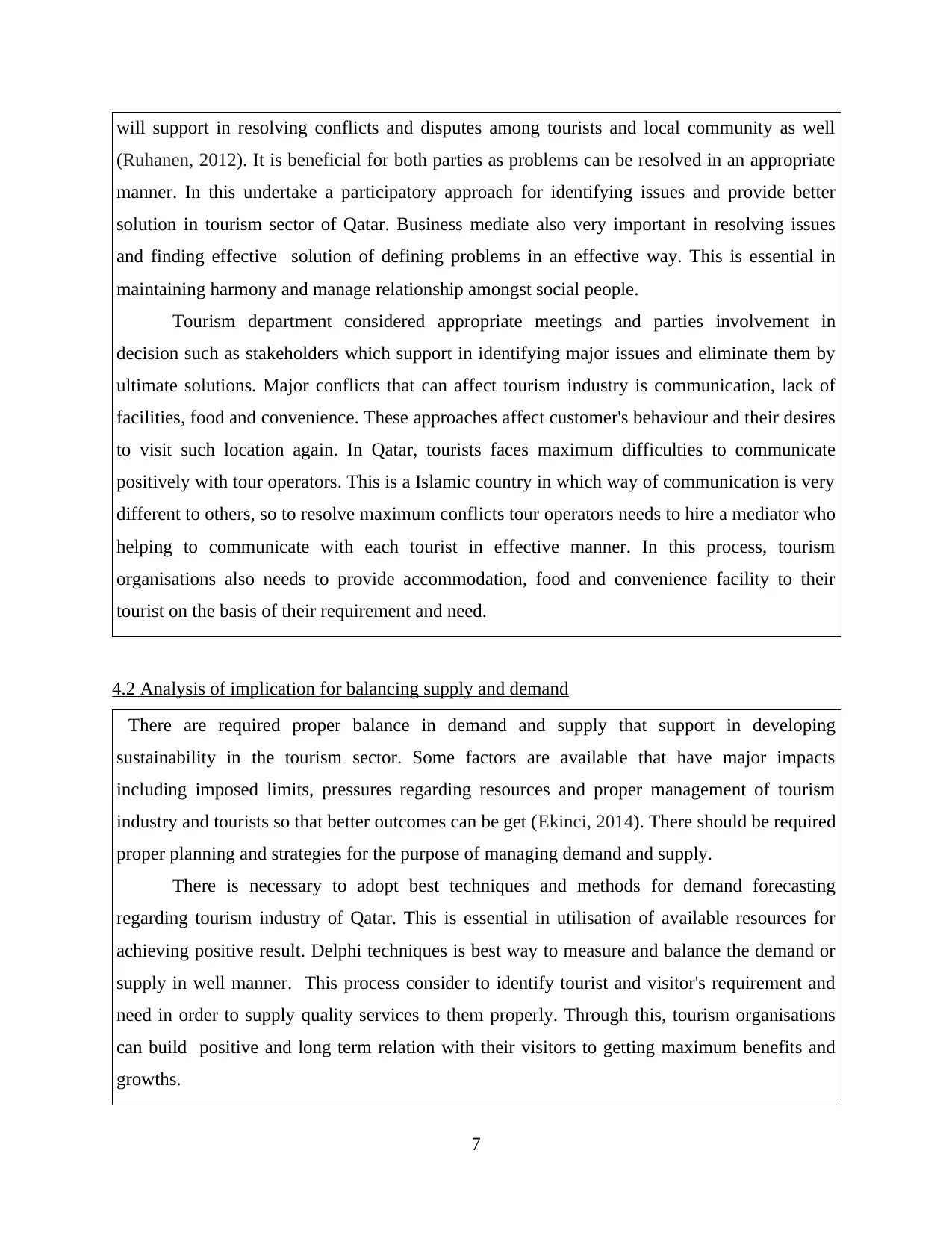
will support in resolving conflicts and disputes among tourists and local community as well
(Ruhanen, 2012). It is beneficial for both parties as problems can be resolved in an appropriate
manner. In this undertake a participatory approach for identifying issues and provide better
solution in tourism sector of Qatar. Business mediate also very important in resolving issues
and finding effective solution of defining problems in an effective way. This is essential in
maintaining harmony and manage relationship amongst social people.
Tourism department considered appropriate meetings and parties involvement in
decision such as stakeholders which support in identifying major issues and eliminate them by
ultimate solutions. Major conflicts that can affect tourism industry is communication, lack of
facilities, food and convenience. These approaches affect customer's behaviour and their desires
to visit such location again. In Qatar, tourists faces maximum difficulties to communicate
positively with tour operators. This is a Islamic country in which way of communication is very
different to others, so to resolve maximum conflicts tour operators needs to hire a mediator who
helping to communicate with each tourist in effective manner. In this process, tourism
organisations also needs to provide accommodation, food and convenience facility to their
tourist on the basis of their requirement and need.
4.2 Analysis of implication for balancing supply and demand
There are required proper balance in demand and supply that support in developing
sustainability in the tourism sector. Some factors are available that have major impacts
including imposed limits, pressures regarding resources and proper management of tourism
industry and tourists so that better outcomes can be get (Ekinci, 2014). There should be required
proper planning and strategies for the purpose of managing demand and supply.
There is necessary to adopt best techniques and methods for demand forecasting
regarding tourism industry of Qatar. This is essential in utilisation of available resources for
achieving positive result. Delphi techniques is best way to measure and balance the demand or
supply in well manner. This process consider to identify tourist and visitor's requirement and
need in order to supply quality services to them properly. Through this, tourism organisations
can build positive and long term relation with their visitors to getting maximum benefits and
growths.
7
(Ruhanen, 2012). It is beneficial for both parties as problems can be resolved in an appropriate
manner. In this undertake a participatory approach for identifying issues and provide better
solution in tourism sector of Qatar. Business mediate also very important in resolving issues
and finding effective solution of defining problems in an effective way. This is essential in
maintaining harmony and manage relationship amongst social people.
Tourism department considered appropriate meetings and parties involvement in
decision such as stakeholders which support in identifying major issues and eliminate them by
ultimate solutions. Major conflicts that can affect tourism industry is communication, lack of
facilities, food and convenience. These approaches affect customer's behaviour and their desires
to visit such location again. In Qatar, tourists faces maximum difficulties to communicate
positively with tour operators. This is a Islamic country in which way of communication is very
different to others, so to resolve maximum conflicts tour operators needs to hire a mediator who
helping to communicate with each tourist in effective manner. In this process, tourism
organisations also needs to provide accommodation, food and convenience facility to their
tourist on the basis of their requirement and need.
4.2 Analysis of implication for balancing supply and demand
There are required proper balance in demand and supply that support in developing
sustainability in the tourism sector. Some factors are available that have major impacts
including imposed limits, pressures regarding resources and proper management of tourism
industry and tourists so that better outcomes can be get (Ekinci, 2014). There should be required
proper planning and strategies for the purpose of managing demand and supply.
There is necessary to adopt best techniques and methods for demand forecasting
regarding tourism industry of Qatar. This is essential in utilisation of available resources for
achieving positive result. Delphi techniques is best way to measure and balance the demand or
supply in well manner. This process consider to identify tourist and visitor's requirement and
need in order to supply quality services to them properly. Through this, tourism organisations
can build positive and long term relation with their visitors to getting maximum benefits and
growths.
7

4.3 Evaluation the moral and ethical issues for enclave tourism
Moral and Ethical issue have major impacts on the travel and tourism sector as well as enclave
tourism. It can affects on the Qatar country because in this included physical safety, financial
security, facilities or services regarding transportation, accommodation and other problems
related with health or safety etc.
Qatar is facing various kinds of problems due to inappropriate services or facilities and
these are affecting on tourism development (Getz, 2012). They can create moral and ethical
issues which have negative impacts so there is necessary to consider CSR and care about social
people with formulating strategies and action plans as well.
TASK 5
5.1 Compare current issues associated with tourism development in developing country and an
emerging destination
There are defined some comparison of current issue which are associated with tourism
development. In this, Qatar and Mexico are undertaken for better comparison of culture,
economic and various factors or issues which can arise in the tourism sector. Here are some
major comparison between both countries such as:
On the basis of Qatar Mexico
Social issues In this, various social factors are
defined that have direct impacts on
the industry. It includes some major
changes in society, values, beliefs
and norms etc. the issues can be
crimes, gambling and other
terrorism that affects on tourists for
visiting place. Qatar is an Islamic
country so people follow moral
behaviours with their guest which
helps in building effective relations
In the Mexico country, there are
several places where tourists
visited and they are attracted
towards different destinations
(Timur, 2012). The current issue
of this country is that they are not
loyal with their culture and social
values. They believes in changes
as per the environment so it can
affects on the tourism sector.
8
Moral and Ethical issue have major impacts on the travel and tourism sector as well as enclave
tourism. It can affects on the Qatar country because in this included physical safety, financial
security, facilities or services regarding transportation, accommodation and other problems
related with health or safety etc.
Qatar is facing various kinds of problems due to inappropriate services or facilities and
these are affecting on tourism development (Getz, 2012). They can create moral and ethical
issues which have negative impacts so there is necessary to consider CSR and care about social
people with formulating strategies and action plans as well.
TASK 5
5.1 Compare current issues associated with tourism development in developing country and an
emerging destination
There are defined some comparison of current issue which are associated with tourism
development. In this, Qatar and Mexico are undertaken for better comparison of culture,
economic and various factors or issues which can arise in the tourism sector. Here are some
major comparison between both countries such as:
On the basis of Qatar Mexico
Social issues In this, various social factors are
defined that have direct impacts on
the industry. It includes some major
changes in society, values, beliefs
and norms etc. the issues can be
crimes, gambling and other
terrorism that affects on tourists for
visiting place. Qatar is an Islamic
country so people follow moral
behaviours with their guest which
helps in building effective relations
In the Mexico country, there are
several places where tourists
visited and they are attracted
towards different destinations
(Timur, 2012). The current issue
of this country is that they are not
loyal with their culture and social
values. They believes in changes
as per the environment so it can
affects on the tourism sector.
8
Secure Best Marks with AI Grader
Need help grading? Try our AI Grader for instant feedback on your assignments.
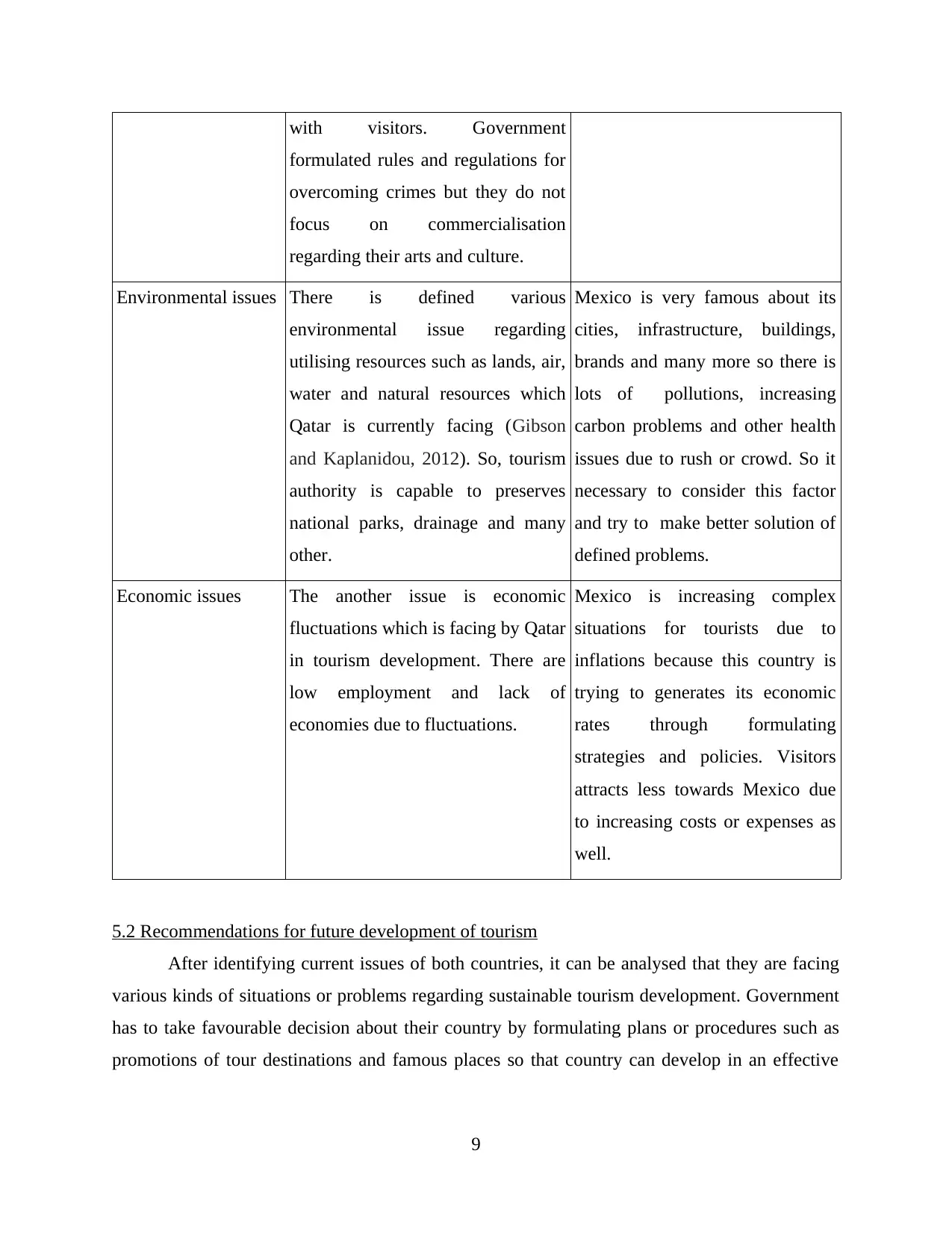
with visitors. Government
formulated rules and regulations for
overcoming crimes but they do not
focus on commercialisation
regarding their arts and culture.
Environmental issues There is defined various
environmental issue regarding
utilising resources such as lands, air,
water and natural resources which
Qatar is currently facing (Gibson
and Kaplanidou, 2012). So, tourism
authority is capable to preserves
national parks, drainage and many
other.
Mexico is very famous about its
cities, infrastructure, buildings,
brands and many more so there is
lots of pollutions, increasing
carbon problems and other health
issues due to rush or crowd. So it
necessary to consider this factor
and try to make better solution of
defined problems.
Economic issues The another issue is economic
fluctuations which is facing by Qatar
in tourism development. There are
low employment and lack of
economies due to fluctuations.
Mexico is increasing complex
situations for tourists due to
inflations because this country is
trying to generates its economic
rates through formulating
strategies and policies. Visitors
attracts less towards Mexico due
to increasing costs or expenses as
well.
5.2 Recommendations for future development of tourism
After identifying current issues of both countries, it can be analysed that they are facing
various kinds of situations or problems regarding sustainable tourism development. Government
has to take favourable decision about their country by formulating plans or procedures such as
promotions of tour destinations and famous places so that country can develop in an effective
9
formulated rules and regulations for
overcoming crimes but they do not
focus on commercialisation
regarding their arts and culture.
Environmental issues There is defined various
environmental issue regarding
utilising resources such as lands, air,
water and natural resources which
Qatar is currently facing (Gibson
and Kaplanidou, 2012). So, tourism
authority is capable to preserves
national parks, drainage and many
other.
Mexico is very famous about its
cities, infrastructure, buildings,
brands and many more so there is
lots of pollutions, increasing
carbon problems and other health
issues due to rush or crowd. So it
necessary to consider this factor
and try to make better solution of
defined problems.
Economic issues The another issue is economic
fluctuations which is facing by Qatar
in tourism development. There are
low employment and lack of
economies due to fluctuations.
Mexico is increasing complex
situations for tourists due to
inflations because this country is
trying to generates its economic
rates through formulating
strategies and policies. Visitors
attracts less towards Mexico due
to increasing costs or expenses as
well.
5.2 Recommendations for future development of tourism
After identifying current issues of both countries, it can be analysed that they are facing
various kinds of situations or problems regarding sustainable tourism development. Government
has to take favourable decision about their country by formulating plans or procedures such as
promotions of tour destinations and famous places so that country can develop in an effective
9
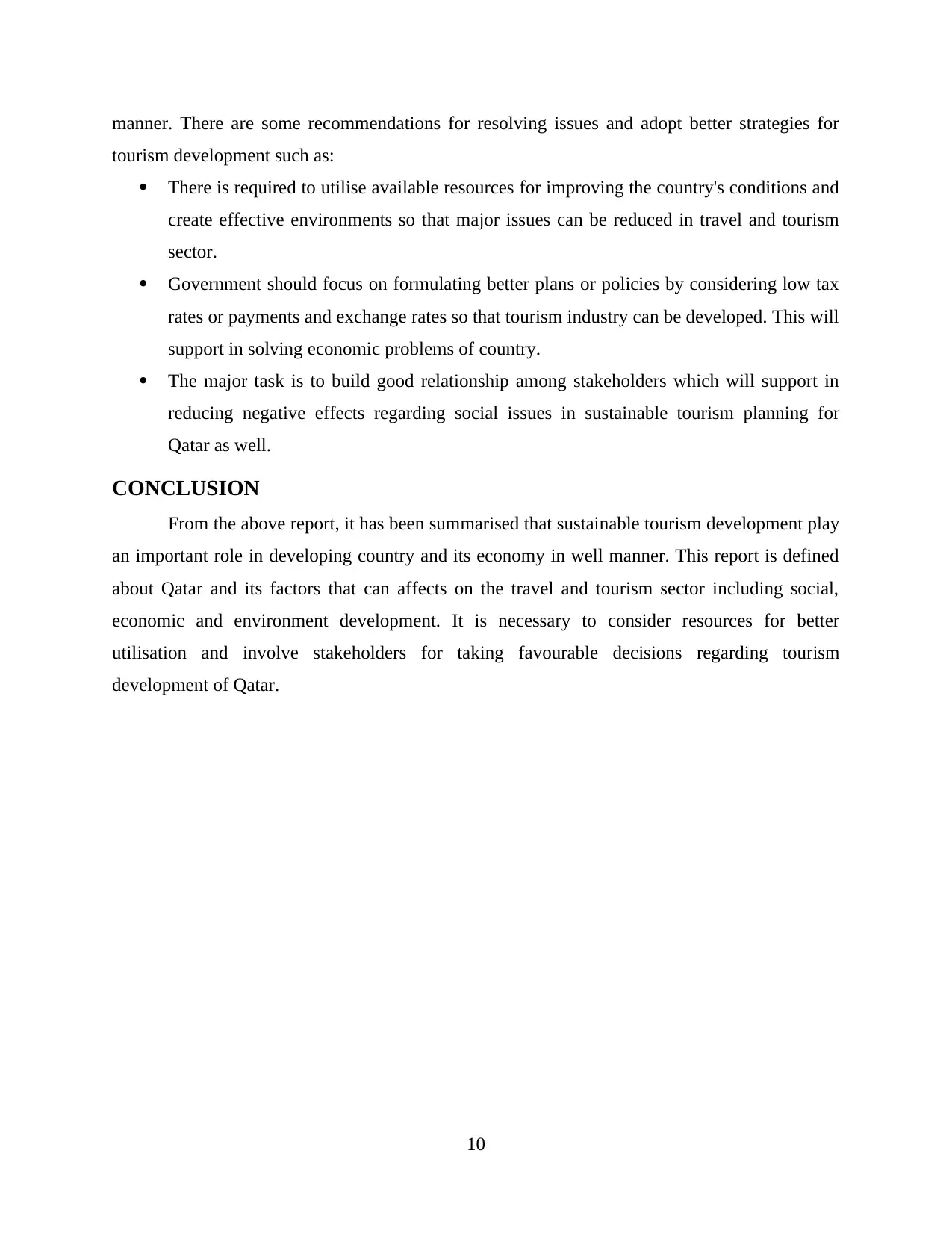
manner. There are some recommendations for resolving issues and adopt better strategies for
tourism development such as:
There is required to utilise available resources for improving the country's conditions and
create effective environments so that major issues can be reduced in travel and tourism
sector.
Government should focus on formulating better plans or policies by considering low tax
rates or payments and exchange rates so that tourism industry can be developed. This will
support in solving economic problems of country.
The major task is to build good relationship among stakeholders which will support in
reducing negative effects regarding social issues in sustainable tourism planning for
Qatar as well.
CONCLUSION
From the above report, it has been summarised that sustainable tourism development play
an important role in developing country and its economy in well manner. This report is defined
about Qatar and its factors that can affects on the travel and tourism sector including social,
economic and environment development. It is necessary to consider resources for better
utilisation and involve stakeholders for taking favourable decisions regarding tourism
development of Qatar.
10
tourism development such as:
There is required to utilise available resources for improving the country's conditions and
create effective environments so that major issues can be reduced in travel and tourism
sector.
Government should focus on formulating better plans or policies by considering low tax
rates or payments and exchange rates so that tourism industry can be developed. This will
support in solving economic problems of country.
The major task is to build good relationship among stakeholders which will support in
reducing negative effects regarding social issues in sustainable tourism planning for
Qatar as well.
CONCLUSION
From the above report, it has been summarised that sustainable tourism development play
an important role in developing country and its economy in well manner. This report is defined
about Qatar and its factors that can affects on the travel and tourism sector including social,
economic and environment development. It is necessary to consider resources for better
utilisation and involve stakeholders for taking favourable decisions regarding tourism
development of Qatar.
10
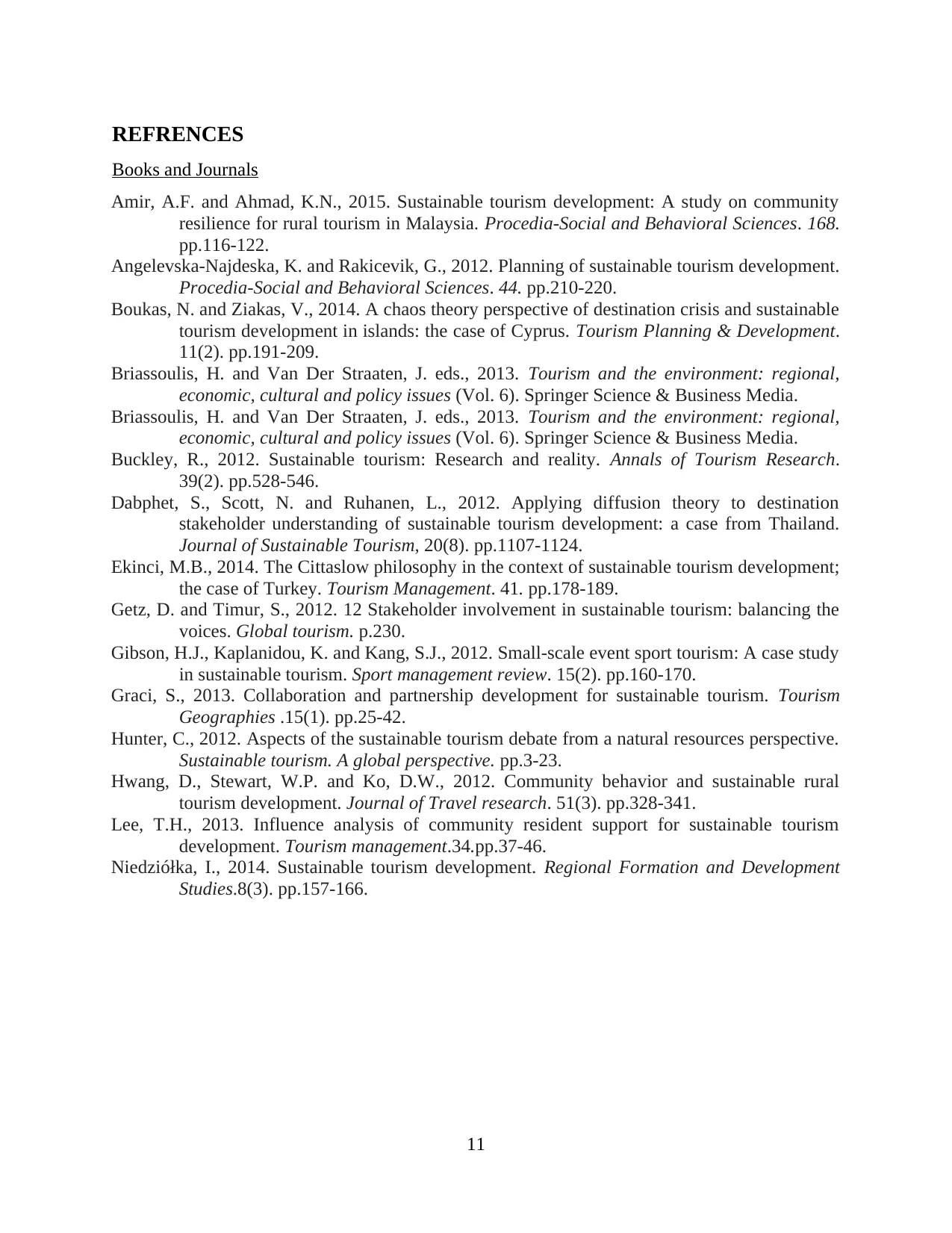
REFRENCES
Books and Journals
Amir, A.F. and Ahmad, K.N., 2015. Sustainable tourism development: A study on community
resilience for rural tourism in Malaysia. Procedia-Social and Behavioral Sciences. 168.
pp.116-122.
Angelevska-Najdeska, K. and Rakicevik, G., 2012. Planning of sustainable tourism development.
Procedia-Social and Behavioral Sciences. 44. pp.210-220.
Boukas, N. and Ziakas, V., 2014. A chaos theory perspective of destination crisis and sustainable
tourism development in islands: the case of Cyprus. Tourism Planning & Development.
11(2). pp.191-209.
Briassoulis, H. and Van Der Straaten, J. eds., 2013. Tourism and the environment: regional,
economic, cultural and policy issues (Vol. 6). Springer Science & Business Media.
Briassoulis, H. and Van Der Straaten, J. eds., 2013. Tourism and the environment: regional,
economic, cultural and policy issues (Vol. 6). Springer Science & Business Media.
Buckley, R., 2012. Sustainable tourism: Research and reality. Annals of Tourism Research.
39(2). pp.528-546.
Dabphet, S., Scott, N. and Ruhanen, L., 2012. Applying diffusion theory to destination
stakeholder understanding of sustainable tourism development: a case from Thailand.
Journal of Sustainable Tourism, 20(8). pp.1107-1124.
Ekinci, M.B., 2014. The Cittaslow philosophy in the context of sustainable tourism development;
the case of Turkey. Tourism Management. 41. pp.178-189.
Getz, D. and Timur, S., 2012. 12 Stakeholder involvement in sustainable tourism: balancing the
voices. Global tourism. p.230.
Gibson, H.J., Kaplanidou, K. and Kang, S.J., 2012. Small-scale event sport tourism: A case study
in sustainable tourism. Sport management review. 15(2). pp.160-170.
Graci, S., 2013. Collaboration and partnership development for sustainable tourism. Tourism
Geographies .15(1). pp.25-42.
Hunter, C., 2012. Aspects of the sustainable tourism debate from a natural resources perspective.
Sustainable tourism. A global perspective. pp.3-23.
Hwang, D., Stewart, W.P. and Ko, D.W., 2012. Community behavior and sustainable rural
tourism development. Journal of Travel research. 51(3). pp.328-341.
Lee, T.H., 2013. Influence analysis of community resident support for sustainable tourism
development. Tourism management.34.pp.37-46.
Niedziółka, I., 2014. Sustainable tourism development. Regional Formation and Development
Studies.8(3). pp.157-166.
11
Books and Journals
Amir, A.F. and Ahmad, K.N., 2015. Sustainable tourism development: A study on community
resilience for rural tourism in Malaysia. Procedia-Social and Behavioral Sciences. 168.
pp.116-122.
Angelevska-Najdeska, K. and Rakicevik, G., 2012. Planning of sustainable tourism development.
Procedia-Social and Behavioral Sciences. 44. pp.210-220.
Boukas, N. and Ziakas, V., 2014. A chaos theory perspective of destination crisis and sustainable
tourism development in islands: the case of Cyprus. Tourism Planning & Development.
11(2). pp.191-209.
Briassoulis, H. and Van Der Straaten, J. eds., 2013. Tourism and the environment: regional,
economic, cultural and policy issues (Vol. 6). Springer Science & Business Media.
Briassoulis, H. and Van Der Straaten, J. eds., 2013. Tourism and the environment: regional,
economic, cultural and policy issues (Vol. 6). Springer Science & Business Media.
Buckley, R., 2012. Sustainable tourism: Research and reality. Annals of Tourism Research.
39(2). pp.528-546.
Dabphet, S., Scott, N. and Ruhanen, L., 2012. Applying diffusion theory to destination
stakeholder understanding of sustainable tourism development: a case from Thailand.
Journal of Sustainable Tourism, 20(8). pp.1107-1124.
Ekinci, M.B., 2014. The Cittaslow philosophy in the context of sustainable tourism development;
the case of Turkey. Tourism Management. 41. pp.178-189.
Getz, D. and Timur, S., 2012. 12 Stakeholder involvement in sustainable tourism: balancing the
voices. Global tourism. p.230.
Gibson, H.J., Kaplanidou, K. and Kang, S.J., 2012. Small-scale event sport tourism: A case study
in sustainable tourism. Sport management review. 15(2). pp.160-170.
Graci, S., 2013. Collaboration and partnership development for sustainable tourism. Tourism
Geographies .15(1). pp.25-42.
Hunter, C., 2012. Aspects of the sustainable tourism debate from a natural resources perspective.
Sustainable tourism. A global perspective. pp.3-23.
Hwang, D., Stewart, W.P. and Ko, D.W., 2012. Community behavior and sustainable rural
tourism development. Journal of Travel research. 51(3). pp.328-341.
Lee, T.H., 2013. Influence analysis of community resident support for sustainable tourism
development. Tourism management.34.pp.37-46.
Niedziółka, I., 2014. Sustainable tourism development. Regional Formation and Development
Studies.8(3). pp.157-166.
11
1 out of 13
Your All-in-One AI-Powered Toolkit for Academic Success.
+13062052269
info@desklib.com
Available 24*7 on WhatsApp / Email
![[object Object]](/_next/static/media/star-bottom.7253800d.svg)
Unlock your academic potential
© 2024 | Zucol Services PVT LTD | All rights reserved.





